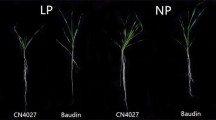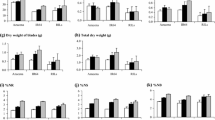Abstract
It is necessary to develop maize plants that are productive when grown in phosphorus (P) deficient soils because of the high cost of P supplementation in soils. The shoot phosphorus utilization efficiency, the whole phosphorus utilization efficiency of plant and root/shoot ratio as well as the quantitative trait loci associated with these traits were determined for a F2:3 population derived from the cross of two contrasting maize (Zea mays L.) genotypes, 082 and Ye107. A total of 241 F2:3 families were evaluated in replicated trials under deficient and normal phosphorus conditions in 2007 at Southwest University. The genetic map constructed by 275 SSR and 146 AFLP markers spanned 1,681.3 cM in length with an average interval of 3.84 cM between adjacent markers. Phosphorus was determined in harvested plants separated into two portions, roots and shoots with leaves. The sum of the two portions was used as an expression for P in the whole plant. By using composite interval mapping, a total of 5–8 distinct QTLs were identified under deficient and normal phosphorus, respectively. SPUE and WPUE under deficient phosphorus were controlled by one QTL, which was in the interval bnlg1518-bnlg1526 (bins 10.04) on chromosome 10. The loci of QTLs were same for SPUE, WPUE and RSR under normal phosphorus, which were in the interval bnlg1518–bnlg1526 (bins 10.04) and P2M8/a-bnlg1839 (bins10.07) on chromosome 10. Unlike regions conferring phosphorus utilization efficiency and root shoot ratio under normal phosphorus, the region under deficient phosphorus showed that genes controlling phosphorus utilization efficiency or root shoot ratio might be different. These results may be useful to breeding programs in marker assisted selections to identify phosphorus tolerant genotypes.
Similar content being viewed by others
References
Agrama RHAS, Moussa ME (1996) Mapping QTLs in breeding for drought tolerance in maize (Zea mays L.). Euphytica 91:89–97. doi:10.1007/BF00035278
Bassam BJ, Caetano AG, Gresshof PM (1991) Fast and sensitive silver staining of DNA in polyacrylamide gels. Ann Biochem 196(1):80–83. doi:10.1016/0003-2697(91)90120-I
Cao WD, Jia JZ, Jin JY (2001) Identification and interaction analysis of QTL for phosphorususe efficiency in wheat. Zhiwu Yingyang Yu Feiliao Xuebao. Plant Nutr Fertil Sci 7((3):285–290
Chen J, Xu L, Cai Y (2008) QTL mapping of phosphorus efficiency and relative biologic characteristics in maize (Zea mays L.) at two sites. Plant Soil 313:251–266. doi:10.1007/s11104-008-9698-x
Guingo E, Hébert Y (1997) Relationships between mechanical resistance of the maize root system and root morphology, and their genotypic and environmental variation. Maydica 42:265–274
Guingo E, Hébert Y, Charcosset A (1998) Genetic analysis of root traits in maize. Agronomy 18:225–235. doi:10.1051/agro:19980305
Hinsinger P (2001) Bioavailability of soil inorganic P in the rhizosphere as affected by root-induced chemical changes: a review. Plant Soil 237:173–195. doi:10.1023/A:1013351617532
Hinsinger P, Gilkes RJ (1996) Mobilization of phosphate from phosphate rock and alumina-sorbed phosphate by the roots of ryegrass and clover as related to rhizosphere pH. Eur J Soil Sci 47:533–544. doi:10.1111/j.1365-2389.1996.tb01853.x
Jones DL, Darrah PR (1995) Influx and efflux of organic acids across the soil-root interface of Zea mays L. and its implications in rhizosphere C flow. Plant Soil 173:103–109. doi:10.1007/BF00155523
Landi P, Albrecht B, Giuliani MM, Sanguineti MC (1998) Seedling characteristics in hydroponic culture and field performance of maize genotypes with different resistance to root lodging. Maydica 43:111–116
Landi P, Giuliani MM, Darrah LL, Tuberosa R, Conti S, Sanguineti MC (2001) Variability for root and shoot traits in a maize population grown in hydroponics and in the field and their relationships with vertical root pulling resistance. Maydica 46:177–182
Landi P, Salvi S, Sanguineti MC, Stefanelli S, Tuberosa R (2002) Development and preliminary evaluation of near-isogenic maize lines differing for a QTL which affects leaf ABA concentration
Liu D, Coloe S, Baird R, Pedersen J (2000) Rapid mini-preparation of fungal DNA for PCR. J Clin Microbiol 38(1):471
Ming F, Mi GH, Zhang FS (2000) Identification of quantitative trait loci affecting tolerance to low phosphorus in rice (Oryza Sativa L.). Kexue Tongbao. Chin Sci Bull 45:520–524
Plenet D, Etchebest, Mollier A, Pellerin S (2000) Growth analysis of maize field crops under phosphorus deficiency I. Leaf Growth. Plant Soil 223:117–130. doi:10.1023/A:1004877111238
Pratapbhanu S, Bhadoria et al (2002) Phosphorus efficiency of wheat and sugar beet seedlings grown in soils with mainly calcium, or iron and aluminium phosphate. Plant Soil 246:41–52. doi:10.1023/A:1021567331637
Riley D, Barber SA (1971) Effect of ammonium and nitrate fertilisation on phosphorus uptake as related to root-induced pH changes at the root–soil interface. Soil Sci Soc Am Proc 35:301–306
Rogers SO, Rehner S, Bledsoe C et al (1989) Exaction of DNA from Basidiomycetes for ribosomal DNA hybridization. Can J Bot 67:1235–1243
Stam P, Van Ooijen JW (2002) Join Map ™ version 3.0: software for the calculation of genetic linkage map. CPRO-DLO, Wagemingen, the Netherlands, 1–5
Stuber CW, Sisco PH (1992) Marker-facilitated transfer of QTL alelles between elite inbred lines and responses in hybrids.Proc. 46th Annual Corn and Shorghum Research. Conference, Am. Seed Trade Assoc., Washington, DC, pp 104–113
Su JY, Xiao YM, Li M et al (2006) Mapping QTLs for phosphorus-deficiency tolerance at wheat seedling stage. Plant Soil 281:25–36. doi:10.1007/s11104-005-3771-5
Tuberosa R, Sanguineti MC, Landi P et al (1998) RFLP mapping of quantitative trait loci controlling abscisic acid concentration in leaves of drought-stressed maize (Zea mays L.). Theor Appl Genet 97:744–755. doi:10.1007/s001220050951
Tuberosa R, Sanguineti MC, Landi P et al (2002) Identification of QTLs for root characteristics in maize grown in hydroponics and analysis of their overlap with QTLs for grain yield in the field at two water regimes. Plant Mol Biol 48:697–712. doi:10.1023/A:1014897607670
Vos Hogers R, Bleeker M, Reijans M et al (1995) AFLP:a new technique for DNA fingerprinting. Nucleic Acids Res 23(21):4404–4414
Wang S, Basten CJ, Zeng ZB (2005) Windows QTL Cartographer 2.5. Department of Statistics, NCSU, Raleigh. (http://statgen.ncsu.edu/qtlcart/WQTLCart.htm)
Wissuwa M (2005) Combining a modelling with a genetic approach in establishing associations between genetic and physiological effects in relation to phosphorus uptake. Plant Soil 269:57–68. doi:10.1007/s11104-004-2026-1
Wissuwa M, Yano M, Ae N (1998) Mapping of QTL for phosphorus-deficiency tolerance in rice (Oryza sativa L.). Theor Appl Genet 97:777–783. doi:10.1007/s001220050955
Xiaolong Yan R, Hong L, Steve E et al (2004) QTL mapping of root hair and acid exudation traits and their relationship to phosphorus uptake in common bean. Plant Soil 265:17–29. doi:10.1007/s11104-005-0693-1
Zhu J, Lynch JP (2004) The contribution of lateral rooting to phosphorus acquisition efficiency in maize (Zea mays L.) seedlings. Funct Plant Biol 31:949–958. doi:10.1071/FP04046
Zhu JM, Mickelson SM, Kaeppler SM et al (2005) Detection of quantitative trait loci for seminal root traits in maize (Zea mays L.) seedlings grown under differential phosphorus levels. Theor Appl Genet 113(1):1–13. doi:10.1007/s00122-006-0260-z
Zhu JM, Kaeppler SM, Lynch JP (2006) Mapping of QTLs for lateral root branching and length in maize (Zea mays L.) under differential phosphorus supply. Theor Appl Genet 111((4):688–695. doi:10.1007/s00122-005-2051-3
Acknowledgments
This research was funded by funds both Chongqing key scientific and technological project “Elite Variety Renovation of Rice and Maize” (CSTC2007AB1045) and Chinese key scientific and technological project (2006BAD13B03).
Author information
Authors and Affiliations
Corresponding author
Additional information
Junyi Chen and Li Xu contributed equally to this work.
Rights and permissions
About this article
Cite this article
Chen, J., Xu, L., Cai, Y. et al. Identification of QTLs for phosphorus utilization efficiency in maize (Zea mays L.) across P levels. Euphytica 167, 245–252 (2009). https://doi.org/10.1007/s10681-009-9883-x
Received:
Accepted:
Published:
Issue Date:
DOI: https://doi.org/10.1007/s10681-009-9883-x




